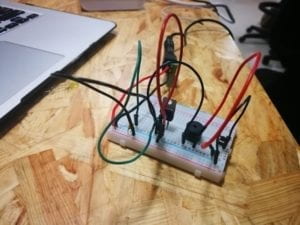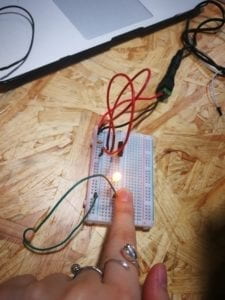Exercises
#1 Doorbell

Capacitor: It stores up electricity while current is flowing into it and releases the energy when the incoming current is removed. It creates a bypass capacity to keep the circuit stable.
Ground: The negative electrode. Connecting the circuit to ground prevents ekectric leakage.
Power: It provides electrical power to run the circuit.
Resistor: It resists but does not block the flow of current. It protects components by controlling the flow of current.
Speaker: The component that makes sound. It acts as the “bell”.
Switch: It controls the flow of current through a junction in a circuit. It controls whether the doorbell goes off by opening and closing.
Voltage Regulator: It automatically maintains a constant voltage level. It stabilize the voltage used by processor component (the speaker).

Photo of doorbell circuit
#2 Lamp

Capacitor: It stores up electricity while current is flowing into it and releases the energy when the incoming current is removed. It creates a bypass capacity to keep the circuit stable.
Ground: The negative electrode. Connecting the circuit to ground prevents ekectric leakage.
LED: A diode that emits light when current flows throughs it. It acts as the lamp.
Power: It provides electrical power to run the circuit.
Resistor: It resists but does not block the flow of current. It protects components by controlling the flow of current.
Switch: It controls the flow of current through a junction in a circuit. It controls whether the LED lights up by opening and closing.
Voltage Regulator: It automatically maintains a constant voltage level. It stabilize the voltage used by processor component (the lamp).

Photo of lamp circuit
#3 Dimmable Lamp

Capacitor: It stores up electricity while current is flowing into it and releases the energy when the incoming current is removed. It creates a bypass capacity to keep the circuit stable.
Ground: The negative electrode. Connecting the circuit to ground prevents ekectric leakage.
LED: A diode that emits light when current flows throughs it. It acts as the lamp.
Potentiometer: A variable resistor. It controls the dimming of the light by controlling the flow of current.
Power: It provides electrical power to run the circuit.
Resistor: It resists but does not block the flow of current. It protects components by controlling the flow of current.
Switch: It controls the flow of current through a junction in a circuit. It controls whether the LED lights up by opening and closing.
Voltage Regulator: It automatically maintains a constant voltage level. It stabilize the voltage used by processor component (the lamp).
Reflection
Since it was my first try to build a circuit, the process of building did not go very smoothly. The first problem I encountered with was how to use the breadboard, namely understanding how are the plugs connected/disconnected.
When reading the diagram, I was confused by the capacitor and the voltage regulator part: What are their functions? How are they connected in the circuit?
Fortunately, I figured out these problems with the help of our faculty and managed to build the doorbell circuit. With this experience, it was easier to build the second one. But when I tested the lamp circuit, I found the LED did not light up. After examination, it turned out that I had connected the LED backwards. The circuit eventually ran after I cleared the mistakes.
Questions
Question 1: After reading The Art of Interactive Design, in what way do you think that the circuits you built today include interactivity?
I think these circuits only include a low level of interactivity according to Crawford’s definition. Information delivered in both input and output in the process of running the circuit are simple: Is the switch on/off? Does the doorbell/lamp goes of? Though there is some reaction between me and the circuit, the information exchanged is not complex and entertaining enough to reach the height of interactivity.
Question 2: How can Interaction Design and Physical Computing be used to create Interactive Art?
Computers can serve as an amplifier of human motions and a converter of art forms, just like the projects introduced in Lieberman’s video. For example, computers can simultaneously project the creating of a graffiti in light forms. Interaction design and computing can function as a new, unprecedently powerful art form, because the unparalleled capacity in processing information of computers. More over, the translation and ampfication of human acts through designing and computing itself can arouse a particular interest in the audience.